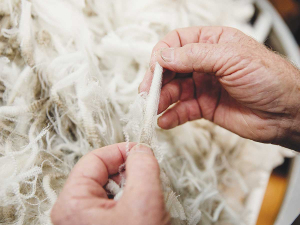Strong wool eyes China
China looks set to play a key role in helping the New Zealand wool sector shift away from trading as a commodity supplier.
 Domestic utilisation of wool is set to double following an edict that government agencies should use wool fibre products in the construction of new and refurbished buildings.
Domestic utilisation of wool is set to double following an edict that government agencies should use wool fibre products in the construction of new and refurbished buildings.
The annual domestic utilisation of wool will double to 30,000 tonnes because of the edict that government agencies should use woollen fibre products in the construction of new and refurbished buildings.
That's the view of Andy Caughey, chief executive of Wool Impact, a partly government-funded advocacy group that says the decision aligns with what is happening overseas and is seen as the new way of driving demand for strong wool.
The move is part of the coalition agreement between National and NZ First. Under the new edict, from 1 July government agencies will be directed to use woollen fibres in the construction and refurbishment of government buildings, where practical and appropriate.
A key driver and advocate of the move is Associate Minister of Agriculture Mark Patterson who says NZ First has been campaigning on this initiative for over a decade. He says way back he brought such a policy to a party convention.
He says the move is not a mandate, but government agencies are expected to commission wool fibre where practical and appropriate.
"If they don't, they have to report back as to why they didn't, so we are putting as much pressure on them as we can. This is about walking the talk and will hopefully inspire the private sector to follow suit," he says.
Patterson says probably more importantly this is a market signal to show the private sector that putting wool into homes is a good thing and hopefully they will follow the example set by government.
He says for too long wool has been left languishing in neutral while the producers of synthetic fibres have invested heavily in innovation and promotion.
Patterson says wool has been synonymous with NZ since the early settlers brought sheep here 200 years ago. And he says it remains the world's third largest wool producer after China and Australia, accounting for about 9% of total world wool production.
"Supporting the NZ wool industry is a key part of the positive steps the Government is taking to add value to the economy," he says.
Patterson says already he's had lots of positive feedback - not only from farmers but also the public who are passionate about wool.
The National Wild Goat Hunting Competition has removed 33,418 wild goats over the past three years.
New Zealand needs a new healthcare model to address rising rates of obesity in rural communities, with the current system leaving many patients unable to access effective treatment or long-term support, warn GPs.
Southland farmers are being urged to put safety first, following a spike in tip offs about risky handling of wind-damaged trees
Third-generation Ashburton dairy farmers TJ and Mark Stewart are no strangers to adapting and evolving.
When American retail giant Cosco came to audit Open Country Dairy’s new butter plant at the Waharoa site and give the green light to supply their American stores, they allowed themselves a week for the exercise.
Fonterra chair Peter McBride says the divestment of Mainland Group is their last significant asset sale and signals the end of structural changes.

OPINION: Your old mate welcomes the proposed changes to local government but notes it drew responses that ranged from the reasonable…
OPINION: A press release from the oxygen thieves running the hot air symposium on climate change, known as COP30, grabbed your…